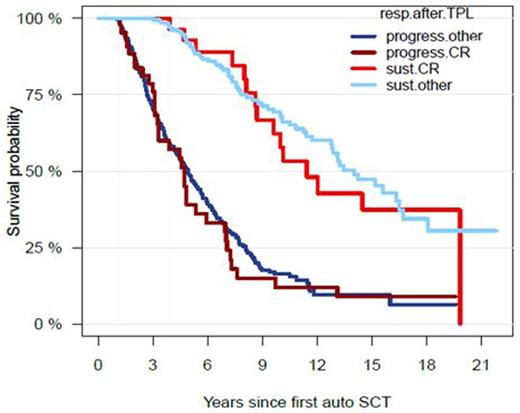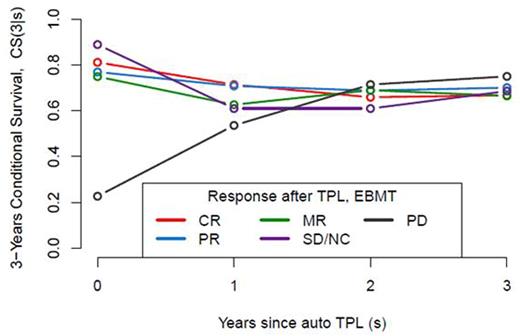Abstract
Background: In the last decade, the introduction of novel agents into multiple myeloma (MM) therapy has significantly improved response rates and enabled long-term survival in a subset of patients. Yet, clinical characteristics of these long-term survivors as well as the exact impact of depth and sustainment of response still remain a matter of debate.
Methods: MM patients treated at our center with high-dose melphalan supported by autologous stem cell transplantation (ASCT) as part of their first-line therapy between June 1992 and July 2014 were retrospectively analyzed. Response assessment was performed 100 days after ASCT according to EBMT criteria, since 2008 response according to IMWG criteria was also available. Overall survival (OS) and progression-free survival (PFS) were calculated from day of first ASCT. Additionally, landmark analyses regarding OS were performed at 1, 2, 3, and 5 years after ASCT. Impact of variables on PFS and OS were analyzed using multivariate Cox regression models. Furthermore, in order to assess evolution of prognosis over time, the conditional survival CS(t|s), which expresses the conditional probability of surviving further t years, was calculated as the ratio of two Kaplan-Meier estimates Ŝ(t) with .
Results: 865 patients were included in this analysis, median age was 57.0 years (range 24-74), 509 were male. New agents based induction therapy was administered in 358 patients, 258 patients underwent tandem ASCT. Following ASCT, 386 patients received maintenance therapy, mainly with interferon or thalidomide. 75 patients proceeded to allogeneic transplantation and were censored at that time. Median PFS was 2.1 years, median OS was 6.4 years.
Analysis of clinical influence factors revealed novel agent based induction therapy (p<0.01), maintenance therapy (p<0.01) and achievement of complete response (CR) (p=0.01) to be significantly associated with prolonged PFS, while older age (p=0.01) and thrombocytes at diagnosis < 150/nl (p=0.02) were identified as risk factors; a negative trend was seen for ISS stage 3 (p=0.067). With regard to OS, novel agent based induction therapy (p<0.01), maintenance therapy (p<0.01) and duration of time to progression (p<0.01) showed a highly significant positive impact, older age (p<0.01) and renal insufficiency at diagnosis (p=0.048) exerted a negative influence.
To assess the importance of duration of response, landmark analyses were performed at 1, 2, 3, and 5 years after ASCT evaluating OS of patients with sustained CR, sustained inferior responses (non-CR), lost CR and lost non-CR at these respective time points. Remarkably, sustainment of any response showed a highly significant impact on survival at each of these time points (p<0.01) with no discernable difference between sustained CR and sustained non-CR patients. Landmark analysis at 1 year is shown in Figure 1. Administration of maintenance therapy independently improved outcome (p<0.01).
Conditional survival regarding the probability to survive further three years CS(3|s) was calculated starting from the time of first ASCT stratified for the different response cohorts (see Figure 2). No significant differences could be found between patients with complete and partial response. In contrast, patients with progressive disease (PD) at day 100 after ASCT had a much lower probability of surviving the following three years after ASCT compared to patients responding to ASCT. However, those patients with PD that did survive the first year after ASCT, achieved a similar conditional three-year survival to that of patients responding initially.
Conclusions: In this large retrospective study, sustainment of response after first-line ASCT was revealed as a major impact factor for OS independent of the depth of response. Administration of maintenance therapy further improved outcome, supporting the hypothesis that interventions prolonging responses achieved after ASCT are essential to reach long-term survival.
OS of patients with sustained vs not-sustained responses at 1-year landmark analysis.
OS of patients with sustained vs not-sustained responses at 1-year landmark analysis.
3-year-conditional survival CS(3|s) after ASCT stratified for responses achieved.
3-year-conditional survival CS(3|s) after ASCT stratified for responses achieved.
Hillengass:Amgen: Consultancy, Honoraria; Celgene: Honoraria; Janssen: Honoraria, Membership on an entity's Board of Directors or advisory committees; BMS: Honoraria; Novartis: Research Funding; Sanofi: Research Funding. Goldschmidt:Celgene: Membership on an entity's Board of Directors or advisory committees, Research Funding; Bristol-Myers Squibb: Membership on an entity's Board of Directors or advisory committees, Research Funding; Chugai: Membership on an entity's Board of Directors or advisory committees, Research Funding, Speakers Bureau; Janssen: Membership on an entity's Board of Directors or advisory committees, Research Funding; Novartis: Membership on an entity's Board of Directors or advisory committees, Research Funding; Millennium: Membership on an entity's Board of Directors or advisory committees, Research Funding; Onyx: Honoraria, Membership on an entity's Board of Directors or advisory committees; Takeda: Membership on an entity's Board of Directors or advisory committees; Amgen: Membership on an entity's Board of Directors or advisory committees. Raab:Amgen: Consultancy, Research Funding; BMS: Consultancy; Celgene: Membership on an entity's Board of Directors or advisory committees; Janssen: Membership on an entity's Board of Directors or advisory committees, Speakers Bureau; Novartis: Consultancy, Research Funding.
Author notes
Asterisk with author names denotes non-ASH members.




This feature is available to Subscribers Only
Sign In or Create an Account Close Modal